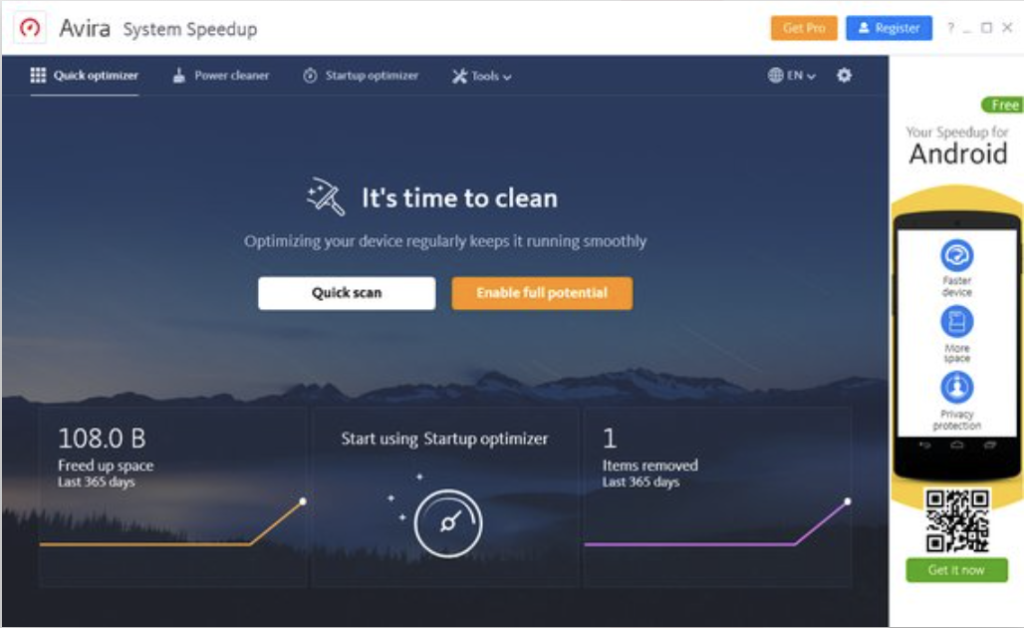Welcome to “overclocking”. It’s often described as how geeks speed up their PCs. Can you really pimp performance safely and without spending a cent? That’s why we created this overclocking guide. The road can be fraught with risks and there are safer ways to optimize performance. By removing unwanted files, browser caches, and more, you can help rejuvenate devices in a safer way—for free. There are trusted solutions from Avira designed to do just that.
What is overclocking your CPU?
What does overclocking mean? Is it all about a faster processor? When a computer is manufactured, its central processing unit or CPU is set to run at a certain maximum speed. If you’re curious about what a CPU is and does, here’s a quick reminder: This small but critical chip sits on the motherboard of your PC and acts as the brain. While you’re surfing the web, playing games, or creating documents, the CPU is busy behind the scenes making all this possible by calculating and interpreting various instructions. (A CPU is sometimes confused with PC memory, but this is a separate component where information is stored. And while we’re dealing with three-letter acronyms, the GPU is different too. This refers to the graphics processing unit which renders images and videos on your display.).
If you run your PC at the speed it was designed to function at, and keep it cool while doing so, it should perform as expected. Yet some of us don’t want to be limited to the set central processor speed… These digital rebels dare to increase the CPU speed by setting a higher clock rate (also called a multiplier) in the computer’s BIOS, forcing it to perform more operations per second.
In a nutshell: When you overclock your PC, you’re trying to unlock greater performance from its central processor while preventing damage to its hardware. It’s a balancing act and you’ll need to closely monitor your system to help prevent any malfunction or even permanent damage.
Why might you want to overclock? Are there benefits?
If it’s the speed you’re after, the advantages are clear: CPU overclocking can improve your computer’s performance and make it run faster without you spending money on an expensive upgrade. It can allow you to perform resource-intensive tasks, like editing videos or photos or gaming, faster and more smoothly. Generally, your PC will feel more responsive. Before you get too ambitious, it’s worth noting that you may not even be able to overclock your CPU! Some motherboards and CPUs come with locked multipliers, making it impossible to alter the factory settings. Intel sells some central processors with unlocked multipliers, specifically for enthusiasts who want to build the ultimate gaming PC, or to code or render with added oomph. (Look for Intel CPUs with “K” in their model number. Also, all Intel processors from the “X” series can be overclocked).
Even if you can overclock your PC, is it worth the effort? There was a time when overclocking generally offered daring users a more responsive desktop and faster performance. Today’s machines are usually powerful enough out-of-the-box so that many of us probably wouldn’t notice a difference. Your computer is likely to be limited by other factors—like a mechanical hard drive (HDD) if it doesn’t have solid-state storage (SSD). (For the uninitiated: HDDs are traditional storage devices with spinning platters for reading and writing data. SSD is a newer technology which stores data on memory chips. It’s considered faster, quieter, and more energy-efficient). Games may be limited by graphics cards, so even hard-core gamers can find that overclocking doesn’t offer the performance gains to justify the effort.
Before you attempt to boost performance, check that your machine is in good health overall. You wouldn’t send an ill person on a marathon (we hope). Malware can damage devices and cause a rise in temperature so reliable online security is essential. Did you know that Avira Free Security packs in protection, online privacy, and performance features?
Is overclocking safe and what are the risks?
When overclocking, you’re pushing your PC beyond its official limits. Do that to a horse, and it will probably fall over. That would be considered cruel and unacceptable, but the situation is slightly less dire for machines. You may have heard rumors about overzealous overclockers frying their machines, but this is extremely unlikely. While the biggest risk of overclocked computers is an increase in the temperature of their central processor or other hardware, if you monitor your computer’s temperature, you can probably overclock safely. You’ll also have some help from your PC to prevent dangerous overheating! Did you know that today’s computers have built-in safeguards to turn off components if they get too hot? If you get overly ambitious and set the clock too high, your PC will most likely just reboot or crash. As you’re left staring at the blue screen of death, it’ll give you time to ponder why you wanted to push your machine so hard anyway… You might also want to cast your mind to your machine’s warranty. When you overclock your PC, you’re doing something that wasn’t intended by the manufacturer. This will usually void your warranty.
While complete hardware failure and permanent damage to the CPU chip are uncommon, they’re still possible. Plus, the central processor may start returning incorrect results or become less stable, so you’ll be dealing with annoying system errors and restarts.
To sum up: Increasing a component’s clock rate will make it perform more operations per second—but this will also generate extra heat and could cause problems like stability issues further down the line. The catchphrase for safer overclocking is cooling and care. And the safest approach of all is simply not to overclock!
If you’re tempted to try overclocking your laptop, don’t! The smaller, sleeker design means that its internal components are packed tightly together. Cooling systems are also more limited than those in desktop computers. Overclocked laptops are therefore even more likely than PCs to overheat and suffer permanent damage. Don’t bully your laptop—it’s so much smaller than you.
A better way: Help optimize your PC and laptop more safely!
To rev up PC performance, it’s important to close unnecessary apps and processes and to regularly delete the apps and files you no longer need. And don’t forget to empty the bin! Did you know that updating your drivers also helps increase speed and stability?
For a regular spring clean, consider a free optimization solution like Avira System Speedup (for PCs). It helps free up disk space by clearing out junk files like temporary files. It can also remove traces left behind from your programs and browser and deletes cache files. Even helping fix the registry is part of its routine maintenance, so you’ll be left with a cleaner, leaner, and hopefully speedier machine. Cleanup tools are also part of Avira security solutions for other devices, including Android and iOS phones.

Still want to overclock? Here’s how…
Are you still interested in overclocking? Are you sure? It’s essential to do your research first and you’ll need to find specific information that applies to your hardware. Thankfully, the web is full of forums like Overclock.net where people discuss their overclocking experiences and share guides for specific CPUs. Please note that aren’t completely identical! Even those of the same model will exhibit small variations as part of the manufacturing process. So, some may have a slightly higher tolerance for heat, while others will be less stable.
Here are essential steps and safeguards to follow before you get started:
Step 1: Benchmark your CPU’s performance. You can use an online tool like XX to see your current performance. Then you’ll know where you started from if you boot performance later. See how top CPU performance checkers compare in the review here.
Step 2: Check your CPU temperature. Then you’ll be able to measure any temperature change that occurs after overclocking. If your computer is already running hot, make sure to fix any overheating issues before you proceed!
Step 3: Perform a CPU stress test. It’s a good idea to see what your CPU is capable of before going all the way. There are tools, like Prime95, that will (rather cruelly) inflict a constant 100% load on all central processor cores for a few hours.
If you’re satisfied that your system is cool and healthy enough to sustain the demands of overclocking, and you’ve logged your benchmark performance, then it’s time to head into your PC’s BIOS. This is where you’ll need to change the settings to overclock your system. Turn your computer off and back on. As it restarts, press the DELETE, F2, or F10 keys repeatedly to access your computer’s BIOS controls. (The exact key combination varies, so you’ll need to experiment or do a Google search. Often a helpful message is displayed, like “Press F10 to enter Setup.”). Your BIOS will usually contain something along the lines of “Advanced CPU Settings” or “OC/Overclocking”. Some BIOS will even provide an “Auto-Overclocking” function, which could give you a bit of a boost safely. Manual overclocking tends to be riskier but usually yields more ambitious results. If you really want to try this, read on. If not, leap to the end of this blog for helpful tips on how to speed up and clean up your PC without overclocking.
The first step to manually overclock is to increase the multiplier by using the base clock built into the motherboard. This is usually set to 100Mhz. If you multiply it by 36, you’ll get 3.6Ghz. Gradually raise the multiplier of one core. Then save your settings, reboot, and use your PC as normal. Is it all functioning well? Good! Then you can head back into the BIOS and dial that multiplier up a bit more and eventually add in more cores—but go slowly! Remember who won that race between the hare and the tortoise…
Now it’s time to find the CPU voltage setting. Look for CPU VCCIN, CPU Vcore, Dynamic Vcore, or CPU Voltage in your BIOS controls. It’s usually set to 1.25. This is again an exercise in patience. Slowly increase this value (to 1.4 for example). By carefully increasing multipliers and voltage, you’ll gradually overlock your system and find the maximum point at which it starts to overheat or becomes unstable.
Is it always about more speed though? Are our growing expectations for instantaneous responses creating unnecessary stress and destroying our ability to focus, and even enjoy? Instead of overclocking, perhaps we should all take more time to appreciate just how far technology has come. At least we don’t have to send faxes. Whatever your choice of device, help keep it running more safely and smoothly.














